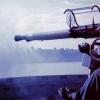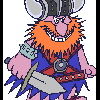-
Posts
1,171 -
Joined
-
Last visited
Reputation Activity
-
 jud got a reaction from Cabbie in HMB Endeavour tiller and steering question
jud got a reaction from Cabbie in HMB Endeavour tiller and steering question
After looking at a bunch of photos taken aboard the The Replica Endeavour, I am starting to look at the Tiller a little differently. Haven't changed my mind that the Tiller needs support to ease stress on the Rudder Head clear down to the rudder. I believe that to ease passage through the water the ship uses it's sails not only for power, but using them to cause the ship to want to track in desired heading. If the ship were balanced, only small rudder adjustments would be needed and the chimney would not be in danger of being broken with the Tiller Ropes. The Tiller Ropes appear to have been looped back through the Tiller ring and lashed to it's self. That lashing looked like it was placed so it could be quickly and easily cast free of the tiller. Hard over rudder positions are not the norm and usually are anticipated in advance. The Tiller is longer than what we think as the norm when using a wheel, perhaps the transition period during this place in time while perfecting the use of the wheel created a need to be able to use both wheel and hands on tiller. Ain't speculation cool.
jud
-
 jud got a reaction from mikiek in footrope stirrups aagh!
jud got a reaction from mikiek in footrope stirrups aagh!
The foot ropes are not hung from a hole in the center of the yard for a good reason, they are suspended over the rear of the yard on the side used by the top-men do their sail handling. Staying on the yard to do their work, is the reason, climbing a rope ladder will quickly show you why, your feet end up out in front of you and leave you hanging from your arms. Keeping your feet to the rear and resting your body on or over the yard can't be done with your feet out under the yard where they would tend to go if the foot ropes were hung directly under the yard, might be able to keep yourself from falling, but you would do little sail handling. Some good methods about how to make the foot-rope hangers and stirrups are noted in this thread, also in a past post there was explained a good way to hang them. On a model it may make no difference to you where and how you hang them, just as long as it is close, your call.
jud
-
 jud reacted to dashi in HMB Endeavour tiller and steering question
jud reacted to dashi in HMB Endeavour tiller and steering question
I've done some calculations as to the possible weight of the 18 foot wooden part of the tiller if made from oak. I am not an engineer but I've got a figure of around 280 pounds - 320 pounds 130 - 150 Kgs.
I'm not sure what the replica tiller is made of but someone mentioned in an earlier post that it might be made from a laminate or it could even be composite which have a much better weight to load ratio than hard wood and therefore wouldn't need the same level of bracing and support. I read that laminate can be as much as 50 to 200% stronger. So until someone can confirm the specification and material of the replica tiller then references to it may not be relevant to answering this question for the possible need of an above deck tiller support at 2/3 rds along it's length.
Another consideration is if the helm tackle were to break then with out some form of stops you would have a 300 pound metal tipped 18 foot pole crashing into the deck and bulwark possibly in rough seas.
As for the abaft fire flu according to Lawrey's book its possible it is a wooden cowl with a swivel top the same shape and size as on replica. But the helm tackle would still need to clear it.
-
 jud got a reaction from druxey in HMB Endeavour tiller and steering question
jud got a reaction from druxey in HMB Endeavour tiller and steering question
druxey; Believe I made a note about that on one of those drawings. They are not finished plans, only a quick illustration of an idea. Also the end of the wood in that tiller is shown with a hidden line. ' dashed ', at the point the Iron begins. I did not reduce the width there because the photos of the rebuild of the Endeavour's tiller in post 31 do not show a narrowing from the wood section of the tiller to the iron end, Shows clearly in DFX but not so well in PDF, one reason for the drawing was to find these things out.
jud
-
 jud got a reaction from dashi in HMB Endeavour tiller and steering question
jud got a reaction from dashi in HMB Endeavour tiller and steering question
druxey; Believe I made a note about that on one of those drawings. They are not finished plans, only a quick illustration of an idea. Also the end of the wood in that tiller is shown with a hidden line. ' dashed ', at the point the Iron begins. I did not reduce the width there because the photos of the rebuild of the Endeavour's tiller in post 31 do not show a narrowing from the wood section of the tiller to the iron end, Shows clearly in DFX but not so well in PDF, one reason for the drawing was to find these things out.
jud
-
 jud got a reaction from WackoWolf in Spiling Tools and Questions
jud got a reaction from WackoWolf in Spiling Tools and Questions
Used one of those when hand drafting and needed to show a transition spiral along a Hwy C/L or ROW, worked fine with pencil or ink, it's around here someplace. Also have a Staedtler 951 60-24 which I liked better. The 951 was heavier, could lead it around smaller curves and was heavy enough to stay where you wanted it. Don't know if they are still available.
Just looked, they are.
Staedtler® Mars® Flexible Curve, 24", Light Blue, less than 10 dollars.jud
-
 jud reacted to Seventynet in Spiling Tools and Questions
jud reacted to Seventynet in Spiling Tools and Questions
I did a bit of spiling on my planking and wales at the bow. I have become very comfortable with the tape method and used a pencil to mark the tape - a sharpie made a mess when I used it. The tape was Scotch (3M) Matte Finish - about 3/4 inch. I have the Staedtler 971 but hardly use it. While I used my mini-band saw for cutting some of the planks it would not have been hard to use a blade. The nice thing about the tape method is that you can put the tape right onto the plank you're going to cut and sand. No matter what method you use to transcribe the curve to the board, there will always be fine tuning to fit the shape to the adjoining surfaces.
Ian
-
 jud got a reaction from mtaylor in Spiling Tools and Questions
jud got a reaction from mtaylor in Spiling Tools and Questions
Used one of those when hand drafting and needed to show a transition spiral along a Hwy C/L or ROW, worked fine with pencil or ink, it's around here someplace. Also have a Staedtler 951 60-24 which I liked better. The 951 was heavier, could lead it around smaller curves and was heavy enough to stay where you wanted it. Don't know if they are still available.
Just looked, they are.
Staedtler® Mars® Flexible Curve, 24", Light Blue, less than 10 dollars.jud
-
 jud got a reaction from daveward in Spiling Tools and Questions
jud got a reaction from daveward in Spiling Tools and Questions
Used one of those when hand drafting and needed to show a transition spiral along a Hwy C/L or ROW, worked fine with pencil or ink, it's around here someplace. Also have a Staedtler 951 60-24 which I liked better. The 951 was heavier, could lead it around smaller curves and was heavy enough to stay where you wanted it. Don't know if they are still available.
Just looked, they are.
Staedtler® Mars® Flexible Curve, 24", Light Blue, less than 10 dollars.jud
-
 jud got a reaction from dashi in HMB Endeavour tiller and steering question
jud got a reaction from dashi in HMB Endeavour tiller and steering question
Dashicat, How I did it was to draw a line from the block anchor point on the tiller to the end of the arc that I had drawn representing the travel line of the end of the tiller. At the point that that arc was tangent, 'the part of the arc furthest from the first line I drew', to the first line, I made a mark and drew a perpendicular from the first line thru the mark on the arc I had just made. Found the mid point along that perpendicular between the first line and the ark, drew a line from the beginning point of that first line through the midpoint to the rail, then used equal distances from that point of intersection with the rail forward and another equal length towards the stern for block positions, repeated until I had two points with a pleasing spread, looking like it would work. That way should keep the tension as even as you could without leading the tiller rope along the arc of the tiller as the wheel was turned. A mirror image used for the other side.
Need to remember that this is just a method I might try if the problem was mine to take care of, there are some attempting to root out some facts, they may not find any, that would be a shame, the drawings we have seen do not look like a working solution to some of us. The Laws of physics are the same today as they were then, so we do have a method of judging any method shown in documents of the past for any deficiency's and conflicts with reality.
Turns on a drum, would not need to increase the turns unless there was slippage. The nature of a drum in that it lets out and equal length it takes in regardless of the number of turns as long as the number of turns is within reason.
I don't think I can add anything more that would useful to this discussion, I do find it interesting but probably need to let it go and watch for more facts.
jud
-
 jud got a reaction from robin b in HMB Endeavour tiller and steering question
jud got a reaction from robin b in HMB Endeavour tiller and steering question
Looking at the build log of the HMB Endeavor by Kiwiron/Occre kit, post 1 and 245 it would appear that I was reinventing the wheel. Worth a look.
jud
-
 jud got a reaction from dashi in HMB Endeavour tiller and steering question
jud got a reaction from dashi in HMB Endeavour tiller and steering question
Looking at the build log of the HMB Endeavor by Kiwiron/Occre kit, post 1 and 245 it would appear that I was reinventing the wheel. Worth a look.
jud
-
 jud got a reaction from mtaylor in HMB Endeavour tiller and steering question
jud got a reaction from mtaylor in HMB Endeavour tiller and steering question
Looking at the build log of the HMB Endeavor by Kiwiron/Occre kit, post 1 and 245 it would appear that I was reinventing the wheel. Worth a look.
jud
-
 jud got a reaction from dashi in HMB Endeavour tiller and steering question
jud got a reaction from dashi in HMB Endeavour tiller and steering question
robin b; Changed the sketch in my post, primarily to see how line widths are effected when printing cad to the Cute PDF software and then bringing that to this site. Refined the original and added a Full Left Rudder configuration. Agree that rigging this way will effect the wheel movement and tiller response, don't consider that much of a problem but if it is, doubling the circumference of the wheel drum would negate the effect. This rigging setup allows plenty of room for the arc but the smoke stack would be in harms way. Are you sure about the additional turns on the wheel drum would need to be increased rigging this way?
jud
-
 jud got a reaction from mtaylor in HMB Endeavour tiller and steering question
jud got a reaction from mtaylor in HMB Endeavour tiller and steering question
robin b; Changed the sketch in my post, primarily to see how line widths are effected when printing cad to the Cute PDF software and then bringing that to this site. Refined the original and added a Full Left Rudder configuration. Agree that rigging this way will effect the wheel movement and tiller response, don't consider that much of a problem but if it is, doubling the circumference of the wheel drum would negate the effect. This rigging setup allows plenty of room for the arc but the smoke stack would be in harms way. Are you sure about the additional turns on the wheel drum would need to be increased rigging this way?
jud
-
 jud reacted to wefalck in How to make best use of your milling machine. Tips and techniques
jud reacted to wefalck in How to make best use of your milling machine. Tips and techniques
Well, this is the 'tools-to-make-more-tools'-syndrom … I know this all too well
-
 jud reacted to Roger Pellett in How to make best use of your milling machine. Tips and techniques
jud reacted to Roger Pellett in How to make best use of your milling machine. Tips and techniques
It seems that my Sherline mill gets used at least as often to build tools/fixtures as it does to make actual model parts. Examples are a fixture for holding propeller blades in the right orientation for soldering and a fixture to hold the very mall blades of my model makers spoke shaves in my honing guide. This means that I use it for materials that do not actually get incorporated into a model- often aluminum.
Roger
-
 jud reacted to dashi in HMB Endeavour tiller and steering question
jud reacted to dashi in HMB Endeavour tiller and steering question
Jud I can see how that might work as it balances out the math because of running the helm ropes through blocks on the bulwark and then blocks on the tiller head and then aft to the tensioning blocks at the bulwarks again (at least that's what I think but not sure). I've just done the math for the drum and instead of 5 turns on the helm drum if the rope were lashed to the tiller head, you would need 9 turns because you have doubled the robe needed for the full movement of the tiller. This in turn would affect the steering by making it twice as light and half as responsive, meaning the helmsperson would need to turn the wheel twice as much to get the same angle of turn at the rudder. I don't know if this would be a good or a bad thing?
Another thought I got from looking at old pictures of helm drums last night was that some of them are concave. It has just occurred to me now this would help take up slack that might be produced on the side the tiller is moving to as the rope from that side is wound on the drum. The side that is wound on would run up the concave taking more rope per turn compared to the side that is winding off as it runs down the concave realising less rope per turn. But you would need to know how much slack to expect from a parallel drum in that situation and then you could work out how much to concave the drum. At least that's the theory that just popped into my head, so who knows if it's right?
-
 jud got a reaction from mtaylor in HMB Endeavour tiller and steering question
jud got a reaction from mtaylor in HMB Endeavour tiller and steering question
Perhaps rigged like this will minimize the slack problem down to a manageable level.
Looks like I may need to start using a white background instead of black like have for years.
TILLER1_Image.pdf
TILLER2_Image.pdf
-
 jud got a reaction from dashi in HMB Endeavour tiller and steering question
jud got a reaction from dashi in HMB Endeavour tiller and steering question
Perhaps rigged like this will minimize the slack problem down to a manageable level.
Looks like I may need to start using a white background instead of black like have for years.
TILLER1_Image.pdf
TILLER2_Image.pdf
-
 jud got a reaction from robin b in HMB Endeavour tiller and steering question
jud got a reaction from robin b in HMB Endeavour tiller and steering question
Perhaps rigged like this will minimize the slack problem down to a manageable level.
Looks like I may need to start using a white background instead of black like have for years.
TILLER1_Image.pdf
TILLER2_Image.pdf
-
 jud reacted to dashi in HMB Endeavour tiller and steering question
jud reacted to dashi in HMB Endeavour tiller and steering question
Wow this is great. Thanks Robin and Joel for mentioning those books. From what I can glean, the sweep was in use since the whipstaff and carried on with the use of the wheel as a tiller support whether above or below the quarterdeck and Pollard refined this idea in 1771 by inventing a system where the rope followed the sweep thereby solving the problem of slack in the steering ropes. Pollard did not invent the sweep.
According to 'The arming and Fitting by Lavery' as mentioned by Robin a sweep following the arc of the tiller was commonly installed on the quarterdecks of smaller vessels that employed a wheel (or or maybe whipstaff) where there wasn't room for a heavy tiller and sweep to fit under the quarterdeck well prior to 1771. In this situation it was fitted 2/3 rds of the tiller length forward of the rudder post primarily as a tiller support where a heavy tiller (which I assume due to the size of the vessel couldn't be operated directly) was rigged to a wheel as in the case of the Bark Endeavour. The sweep on the 1771 drawing is for this later purpose and I don't think related to Pollards design.
Not only that but I think the physics of having a sweep provided a minor solution to the rope tension problem by removing the arc produced by the angle of the stern post imposed on a rigid tiller. Which brings me to the purpose of the tiller brace which I now don't think was there to form a rigid connection to the rudder post but instead to help brace a pivoting connection needed for a heavy tiller to ride on the sweep as intended. How exactly the tiller brace did this as yet I haven't figured that out but am working on it and have some ideas and hopefully more research will reveal something.
-
 jud reacted to jbshan in HMB Endeavour tiller and steering question
jud reacted to jbshan in HMB Endeavour tiller and steering question
The below-deck tiller and sweep has the sweep closer to the end of the tiller and small rollers on the rim of the quadrant to reduce friction on the tiller rope.
This would be for larger ships, although Endeavour has headroom enough below, and if there is horizontal room for the tiller to reach it's functional limits on deck, there will be room enough in the cabin.
I think some of the drawings may be for a refit, if not for the voyage and the replica got it wrong, then for afterward. That gooseneck bothers me a bit, also. It's only a foot or so long; you wouldn't gain much advantage from the extra length. Why not simply do away with it and put the ropes on the wooden part as was done on many, even fairly large, vessels, but perhaps not ocean-going. It doesn't make sense, and if it doesn't make sense, maybe there's something not right going on.
-
 jud reacted to daveward in Tools and Supplies for My "Shipyard"
jud reacted to daveward in Tools and Supplies for My "Shipyard"
I appreciate the suggestions, everyone! I am sure I'll be adding some of the tools you guys mentioned to my collection as I progress through the build. I ended up getting a standard swing-arm lamp, and I put a 850-lumen 5000K natural daylight LED bulb in it. I think it will provide plenty of light for my work. I have also purchased everything on my list, as well as a dressmaker's tape measure, a small 3-inch vise, some extra tiny drill bits, some map pins, some 3/4" spring clamps, rubber bands, toothpicks, and a bottle of rubbing alcohol. The sandpaper grits I selected were 100, 150, 220, and 400. I ended up going with Zap-A-Gap glue (with some Z-Ends), and the wood glue I selected was Titebond III. I am also probably going to pick up an Optivisor and a helping hands with a magnifier. For now, it's just a matter of waiting for the kit. Since this will be my first model, I went ahead and spent the money on the Lauck Street Shipyard Lady Nelson DVD set. While it was expensive, I think it will be beneficial to watch a step-by-step build of the exact same kit I will be constructing. I'm sure I'll learn a lot, and the skills I develop can be used on future builds, as well. Between the DVDs and the wealth of information here on the forum, I think I stand a good chance of producing an aesthetically pleasing model that I can display in my home once I'm done. Thanks again for your comments and suggestions! Happy modeling!
-
 jud got a reaction from mtaylor in HMB Endeavour tiller and steering question
jud got a reaction from mtaylor in HMB Endeavour tiller and steering question
My two cents about the shown ark on the 1768 drawing makes sense to me, if it was placed between the deck and tiller arm as it appears to be. Think about the moment arm acting on the rudder post just from the weight of that heavy tiller, then add the iron work at the end. Because of the location and height of the steering gear attachment point above the deck in the 1768 drawing would also add some more downward force to the load on the tiller that the rudder post would need to support, the rudder post would soon snap off. The reinforcing iron and bolts between the rudder post and tiller aboard the replica will not save the rudder post from damage, it would quicken it by making the joint stiffer, they must have lots of problems with the steering gear. Suspect the ark in question and shown on the 1768 drawing lies on the main deck for the tiller arm to rest and run along, probably the arc device was topped with a well greased iron cap and a iron pad attached to the bottom of tiller arm to ease movement and stop excessive wear.
jud








